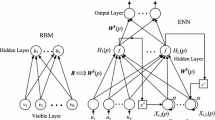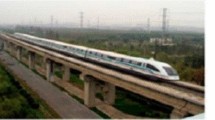Abstract
The maglev train has been successful in practice as a new type of ground transportation. Owing to the inherent nonlinearity and open-loop instability of the electromagnetic suspension (EMS) system, an analogue or a digital controller is used to control the maglev trains’ stability. With the rapid development of embedded systems and artificial intelligence, intelligent digital control has begun to replace the conventional analogue control technology creating a new approach to the EMS control system. This paper proposes a hardware module for an embedded levitation controller based on digital signal processor and field programmable gate array, hence producing an open loop mathematical model of the embedded maglev control system. The deep learning controller is then developed based on a deep belief network (DBN) algorithm and a proportional integral derivative feedback controller. The simulations are conducted in the MATLAB environment after training the DBN. Simulation results are compared with those obtained from the conventional controller. Finally, experiments are implemented to examine the feasibility in practice of the application of the DBN into a maglev embedded control system. The system, with the proposed controller, can accurately track the target airgap of 8 mm. The maximum tracking error of sinusoidal trajectory is 0.17 mm and the maximum tracking error of step trajectory is 0.98 mm. Both simulation and experimental results are included in this paper to show that the proposed deep learning controller can be more robust and less complicated to implement in maglev control applications.




























Similar content being viewed by others
References
Thornton RD (2009) Efficient and affordable maglev opportunities in the United States. Proc IEEE 97:1901–1921
Sun Y, Xu J, Qiang H, Chen C, Lin G (2019) Adaptive sliding mode control of maglev system based on RBF neural network minimum parameter learning method. Measurement 141:217–226
Boldea I, Tutelea L, Xu W et al (2017) Linear electric machines, drives, and MAGLEVs: an overview. IEEE Trans Ind Electron 65(9):7504–7515
Sun Y, Xu J, Qiang H, Lin G (2019) Adaptive neural-fuzzy robust position control scheme for maglev train systems with experimental verification. IEEE Trans Ind Electron 66(11):8589–8599
Sun Y, Xu J, Qiang H, Wang W, Lin G (2019) Hopf bifurcation analysis of maglev vehicle–guideway interaction vibration system and stability control based on fuzzy adaptive theory. Comput Ind 108:197–209
Surya S, Ramyashree S, Nidhi R et al (2015) Development of a simple MAGLEV system for a low-speed wind tunnel. In: 2015 International conference on power and advanced control engineering (ICPACE). IEEE, pp 441–444
Chuan M, Changsheng Z (2017) Unbalance compensation for active magnetic bearing rotor system using a variable step size real-time iterative seeking algorithm. IEEE Trans Ind Electron 65(5):4177–4186
Anuradha P, Rallapalli H, Narsimha G (2018) Energy efficient scheduling algorithm for the multicore heterogeneous embedded architectures. Des Autom Embed Syst 22(1–2):1–12
Kaleem Z, Yoon TM, Lee C (2015) Energy efficient outdoor light monitoring and control architecture using embedded system. IEEE Embed Syst Lett 8(1):18–21
de Souza RH, Savazzi S, Becker LB (2015) Network design and planning of wireless embedded systems for industrial automation. Des Autom Embed Syst 19(4):367–388
Greatwood C, Richards AG (2019) Reinforcement learning and model predictive control for robust embedded quadrotor guidance and control. Auton Robots 43:1681–1693
Tutuncu K, Ozcan R (2019) Embedded fuzzy logic control system for refrigerated display cabinets. Arab J Sci Eng 44:9529–9543
Gupta C, Tewari VK, Kumar AA et al (2019) Automatic tractor slip-draft embedded control system. Comput Electron Agric 165:1–11
Hidalgo MC, Garcia C, Angélico BA et al (2019) Embedded sliding mode controller applied to control valves with high friction. J Control Autom Electr Syst 30(5):677–687
Sun Y, Qiang H, Xu J et al (2019) IoT-based online condition monitor and improved adaptive fuzzy control for a medium-low-speed maglev train system. IEEE Trans Ind Inform. https://doi.org/10.1109/TII.2019.2938145
Mantere M, Uusitalo I, Sailio M et al (2012) Challenges of machine learning based monitoring for industrial control system networks. In: 26th International conference on advanced information networking and applications workshops. IEEE, pp 968–972
Zhu X, Guan C, Wu J et al (2006) Expectation-maximization method for EEG-based continuous cursor control. EURASIP J Adv Signal Process 2007(1):1–10
Sze V, Chen YH, Yang TJ et al (2017) Efficient processing of deep neural networks: a tutorial and survey. Proc IEEE 105(12):2295–2329
Zeng Z, Pantic M, Roisman GI et al (2008) A survey of affect recognition methods: audio, visual, and spontaneous expressions. IEEE Trans Pattern Anal Mach Intell 31(1):39–58
Yan C, Xie H, Yang D et al (2017) Supervised hash coding with deep neural network for environment perception of intelligent vehicles. IEEE Trans Intell Transp Syst 19(1):284–295
Ji S, Xu W, Yang M et al (2012) 3D convolutional neural networks for human action recognition. IEEE Trans Pattern Anal Mach Intell 35(1):221–231
Umer S, Dhara BC, Chanda B (2019) Face recognition using fusion of feature learning techniques. Measurement 146:43–54
Ye L, Yao C, Tao L, Cai R, Gong X (2018) Convolutional neural network construction method for embedded FPGAs oriented edge computing. J Comput Res Dev 55(3):551–562
Wan L, Jinning D, Sihui C et al (2019) Design and simulation of Butterworth lowpass filter based on CFA. J Hubei Univ (Nat Sci) 41(3):313–317
Hinton GE, Osindero S, Teh YW (2006) A fast learning algorithm for deep belief nets. Neural Comput 18(7):1527–1554
Larochelle H, Bengio Y, Louradour J et al (2009) Exploring strategies for training deep neural networks. J Mach Learn Res 1(10):1–40
Aoyagi M (2010) Stochastic complexity and generalization error of a restricted Boltzmann machine in Bayesian estimation. J Mach Learn Res 11(1):1243–1272
Acknowledgements
This work was supported by the National Natural Science Foundation of China under Grant 51905380, by China Postdoctoral Science Foundation under Grant 2019M651582, by independent Research Project of State Key Laboratory (No. TPL1711) and Funded Project of National Key Research and Development Plan (2016YFB1200601).
Author information
Authors and Affiliations
Corresponding author
Additional information
Publisher's Note
Springer Nature remains neutral with regard to jurisdictional claims in published maps and institutional affiliations.
Rights and permissions
About this article
Cite this article
Gao, Dg., Sun, Yg., Luo, Sh. et al. Deep learning controller design of embedded control system for maglev train via deep belief network algorithm. Des Autom Embed Syst 24, 161–181 (2020). https://doi.org/10.1007/s10617-020-09237-3
Received:
Accepted:
Published:
Issue Date:
DOI: https://doi.org/10.1007/s10617-020-09237-3




